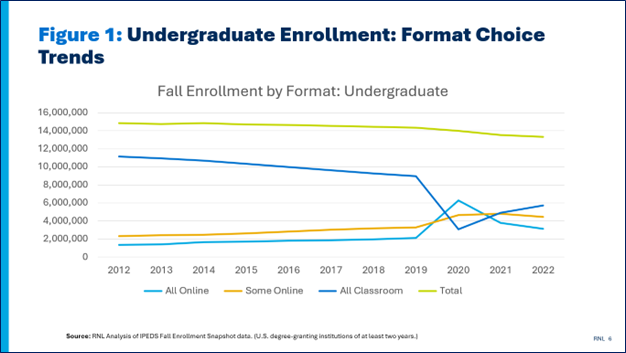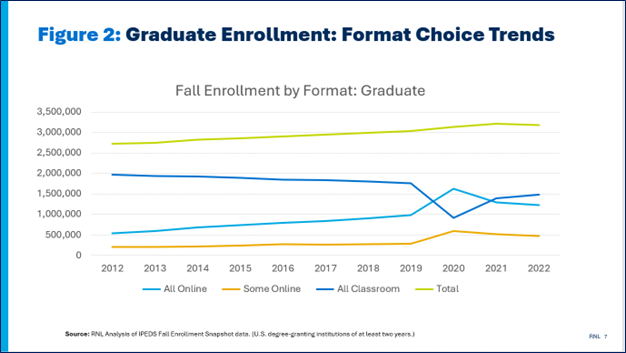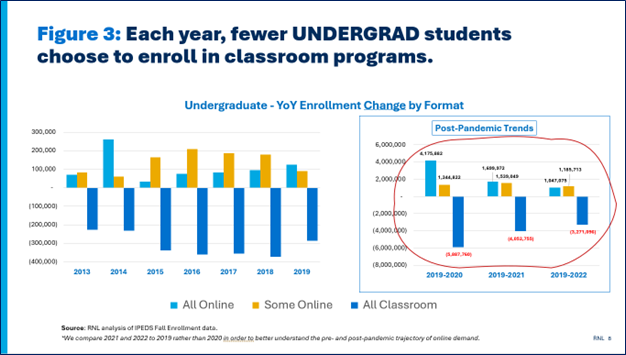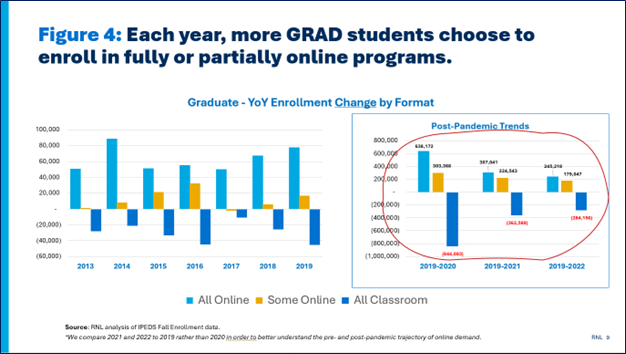enrollment
Is Online Education Really in Trouble? No, and Here Is Why!
The U.S. Department of Education has finally released its first look into the 2022-2023 academic year. Their IPEDS snapshot data showcase how many students were enrolled in different types of programs on a given fall semester day. There are three important findings:
- Undergraduate enrollment continued its decline but slowed to -2 percent (see Figure 1)
- Graduate enrollment contracted by 1 percent—the first time in a decade (Figure 2)
- Students opting to enroll in all online or some online courses also contracted (Figures 1 and 2).
While these are important data, I have previously written that the best data on format preferences reflect enrollment over the full 12-month academic year. Such data in 2021 indicated that nearly 6 million additional students enrolled after the fall semester and all but 200,000 were enrolled in either all online or some online courses.
What do the new data mean for institutions that have pivoted quickly to expand their online offerings? Is a crisis at hand? Inside Higher Education’s headline did nothing to alleviate concern: “Students Distancing From Distance Learning”. Their opening line reinforced the bad news: “The number of students participating in online learning is continuing a post-pandemic decline, new enrollment data show.” The story proceeded in a more measured manner, but could cause alarm for those scanning the headlines. It is true that the number of students opting to enroll in all online or some online courses contracted for the second year. This is because in 2020, millions of classroom students were forced into online, remote, or hybrid study. Last year I posited that it is highly unlikely that things will return to a pre-pandemic “normal,” but defining the “new normal” would take a few years. In what follows, we use data to understand what is going on and what it means for institutional planning and execution.


Where we really are
Since the pandemic, I’ve been using IPEDS data to track changes in student format choices not through a year over year (YoY) comparison, but rather by comparing each year to 2019 (the last pre-pandemic year). We use this methodology to present net new/additional students by format on the right side of Figures 3 and 4. This is a more useful way to use the data to understand the long-term impact of pandemic-era experiences, and how that has affected student format preferences. Note that the left side of these two charts presents pre-pandemic data using the traditional YoY methodology.
What do the data say? My news headline would be “Millions More Students Continue to Choose Fully Online/Some Online Study.”
Undergraduate
In 2022 more than 2.2 million more undergraduate students decided to enroll in all or some online courses than in 2019—with those opting for “some online” outpacing “all online”. Compare this with 3.2 million fewer who opted to enroll in all classroom study. This does not present a strong case for returning the focus to classroom programs, while presenting a clear need to prioritize the offering of online courses within classroom programs and then fully online programs. The IPEDS 12-month academic year data (both pre- and post-pandemic) also indicates that more than 5 million additional undergraduates enroll at other times of the year and all but 200,000 select all or some online courses.

Graduate
In 2022 more than 424,000 more graduate students decided to enroll in all or some online courses than in 2019—with those opting for “all online” significantly outpacing “some online”. Compare this with more than 284,000 fewer who opted to enroll in all classroom study. Again, this does not present a strong case for returning the focus to classroom programs. Institutions need to continue to prioritize offering fully online programs and also online courses within classroom programs. Similar to undergraduate trends, the IPEDS 12-month academic year data indicates that more than 812,000 additional graduates enroll at other times of the year and all of them select all or some online courses.

Talk with our graduate and online enrollment experts
Ask for a free consultation with us. We’ll help you assess your market and develop the optimal strategies for your prospective graduate students and online learners.
What does this mean for institutions?
- Undergraduate leaders need to invest in the creation of high-quality online courses within all classroom programs. Institutions that want to continue to meet the expectations and preferences of undergraduate students must develop online courses for their classroom students. Institutions that offer higher quality experiences than some available today will be at the forefront of innovation—and ahead of proposed regulatory changes. RNL’s instructional design services now include a course quality audit and course optimizer and are helping improve the student experience.
- Graduate leaders need to determine the programs with the greatest online potential, then build programs that engage students and help them persist and finish. This starts with solid market insights and strong internal enrollment planning processes that bring all institutional stakeholders to the table. Do you have internal capacity to execute on these functions? RNL’s consulting and market research services have helped hundreds of institutions both evaluate program options and develop a strategic approach to enrollment growth that incorporates all campus stakeholders.
- Marketing leaders need to focus outreach and advertising on their home region and ensure that they are highly visible in search results. A 2023 RNL survey indicates that 40 percent of online students live within 25 miles of the institution in which they enroll, and 90 percent start their search on a search engine. Institutions should assume that they are invisible—even to students in their backyard—unless their programs come up in search results. RNL’s digital lead generation services help hundreds of institutions optimize both their organic search results and perfect their paid digital marketing presence.
- Recruitment leaders need to be ready to respond quickly and personally to every inquiry and question. RNL research shows that online students expect responses within hours or even minutes and are much more likely to choose the institution that responds to them first or accepts them first. That means that even the best, highest quality programs and marketing campaigns will fall flat if response is not timely. RNL’s recruitment and cultivation services help institutions with cultivation and courting from inquiry to application and from application to enrollment and much more. Our new Transcript Service will even retrieve applicants past transcripts for them.
Talk with our experts about strengthening your online marketing and recruitment
Our online enrollment experts can help you identify opportunities to engage students, increase yield, and provide world-class online courses. Reach out today for a complimentary consultation.
